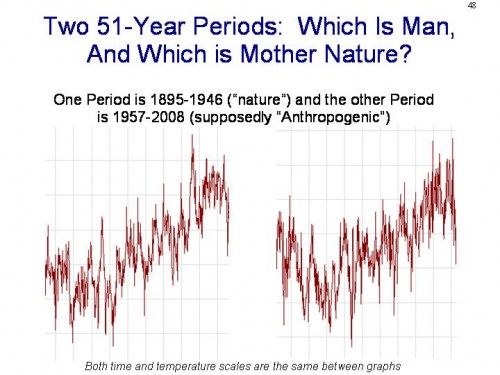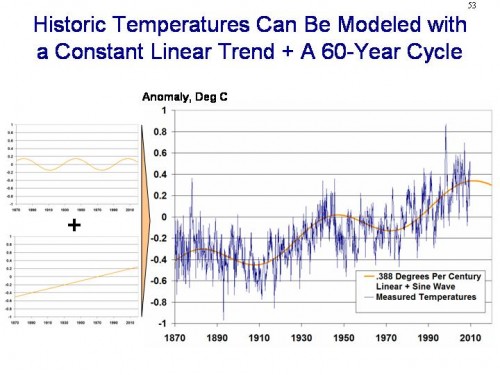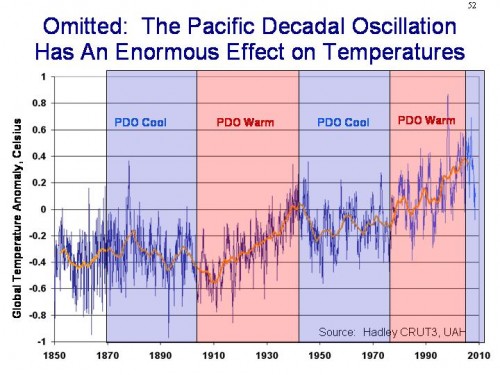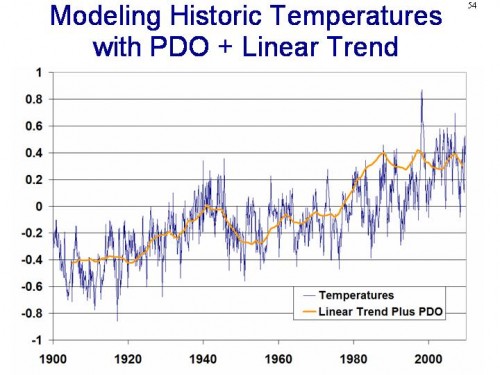From an interview with Judith Curry
They don’t disprove anthropogenic global warming, but we can’t airbrush them away. We need to incorporate them into the overall story. We had two bumps—in the ’90s and also in the ’30s and ’40s—that may have had the same cause. So we may have exaggerated the trend in the later half of the 20th century by not adequately interpreting these bumps from the ocean oscillations. I don’t have all the answers. I’m just saying that’s what it looks like.
The bump in the 90’s is important because its slope is considered exhibit A in the evidence for strong anthropogenic global warming by alarmist scientists. Climate scientists have argued that the “bump” is so steep that it could not be natural and has to be man made.
I am not going to diss on Ms. Curry, as she is in the minority of climate scientists who don’t treat scientific disagreements as proof of evil conspiracies. I often say that reasonable people can disagree, and she seems to approach scientific debate in this manner, rather than as a quest for religious conformity.
However, how much of a pass do we really give climate scientists for missing something so obvious as ocean cycles, particularly since even untrained amateurs like myself have been pointing out this omission for years. For example:

Hmm, the 90’s seem suddenly less unprecedented. In fact, from here, there seem to be a lot of bumps:
Period Length Trend
(Degrees C per decade)Significance 1860-1880 21 0.163 Yes 1910-1940 31 0.15 Yes 1975-1998 24 0.166 Yes 1975-2009 35 0.161 Yes
In fact, one can model past temperatures as a linear trend (that started well before CO2 was added in any substantial quantity) and periodic bumps

I wonder what periodic effect could be causing the bumps?

Even leaving out the AMO and other cycles and just simplifying to the PDO, it sees that ocean cycles might be important. Again, temperatures over the last 100+ years look a lot like a linear trend plus ocean cycle-driven bumps


But you are not a qualified climate scientist, so you are not qualified to make any sort of critical review of any claim of AGW.
And and and qualified climate scientists hav ereviewed all of this already and have rendered their judgement: CO2 caused it all.
And this false similarity you refer to between those two periods in question do not reflect the subtle but deadly reality of the climate crisis mankind’s CO2 has caused.
>sarcasm off<
>sarcasm – offabuse – off (for now anyway)spelling – offappeal to authorities – onresponse in proportion to statement – offdenial of rights to an informed opinion – on<
I think that Judith Curry may become quite a significant commentator in the near future. Her honesty appears to be in very stark contrast to the stonewalling and denialism that seems to prevail in the rest of the AGW camp. Even if she does not change sides I think that what she says will be worth listening to because of her apparent sincerity.
What’s causing the trend?
I can take the PDO or sunspots cycling up and down long into the future, but what is it that makes the system ratchet up the temperature with each cycle?
Dave:
“What’s causing the trend?”
While this post focuses on the 60-year climate periodicity, there is also a lot of evidence for a millennial-scale climate periodicity. Look up “Bond events” and “Dansgaard-Oescher events” in a search engine for some details. It is very plausible that a general warming trend since the 1600s is mostly due to being in the warming half of this cycle.
It is also plausible that increased CO2 is contributing to the recent part of this warming trend as well.
http://research.aerology.com/aerology-analog-weather-forecasting-method/ Study based on repeating cycles in the weather, that might shed some light on how this all comes down to repeating patterns in the weather and climate that have a compounding of several patterns that can be either separated and studied, or the composite signal base period found and analyzed over the whole period with consideration of some of the more dominate driving periods. Either way will yield answers to questions that need to be asked before the problem can be defined enough to look for the right answers to solve the riddle that is weather.
The keys are in the interlocking patterns of interactions that mankind as a total cannot influence at all, the output of the sun the orbital interactions of the Earth-Sun-moon, with the inner planets, and the long term influences of the outer gas giant planets we cannot even visit except with robots, (soon maybe).
@ Dave:
Geologically speaking, we are coming out of a glacial period, which is something like a mini ice age. Basically, there are oscillations of temperatures that range over the time scale of 10’s of thousands of years and millions of years. In the past 40k years we have seen three such glacial periods with interglacial or warming periods inbetween them. The last glacial period ended approximately 10k years ago, and we are currently in, and have been in for those 10k, and interglacial or warming period. Essentially, we are coming out of of a colder period in earth history and moving into a warmer period.
I don’t know how much bearing this has specifically on the data shown in the graphs above, as it in the thousands of years timeframe, but it is certainly something to be aware of in general.